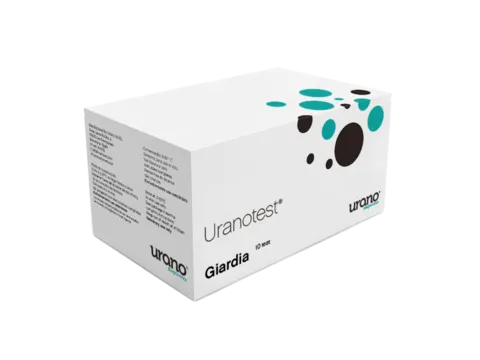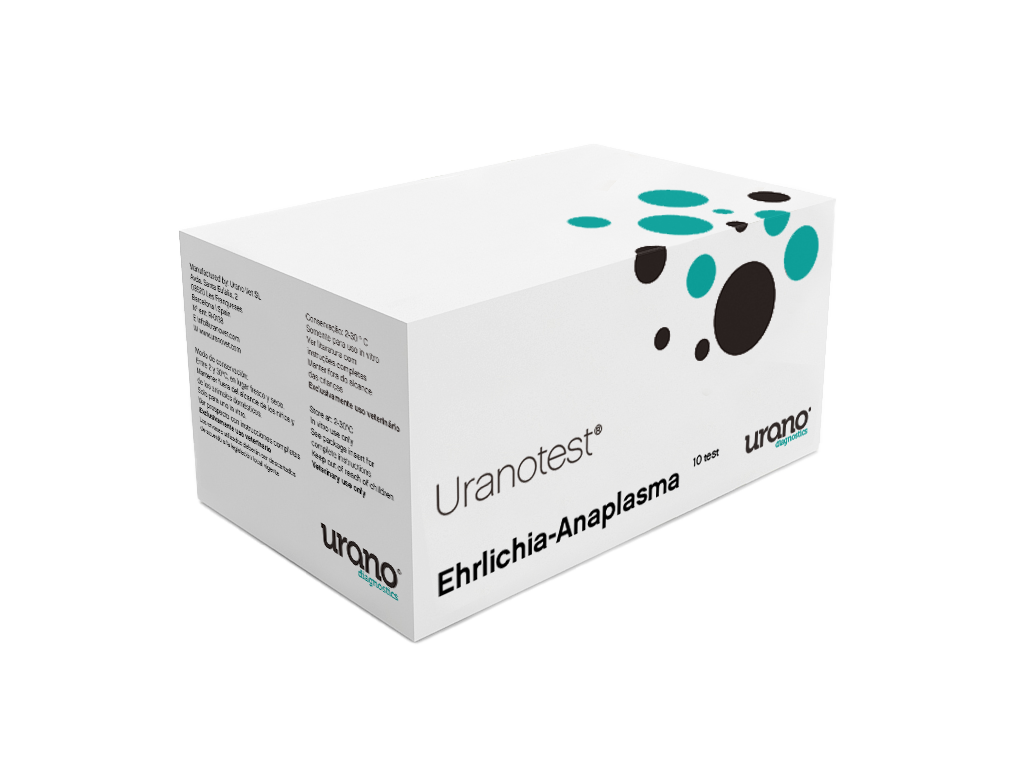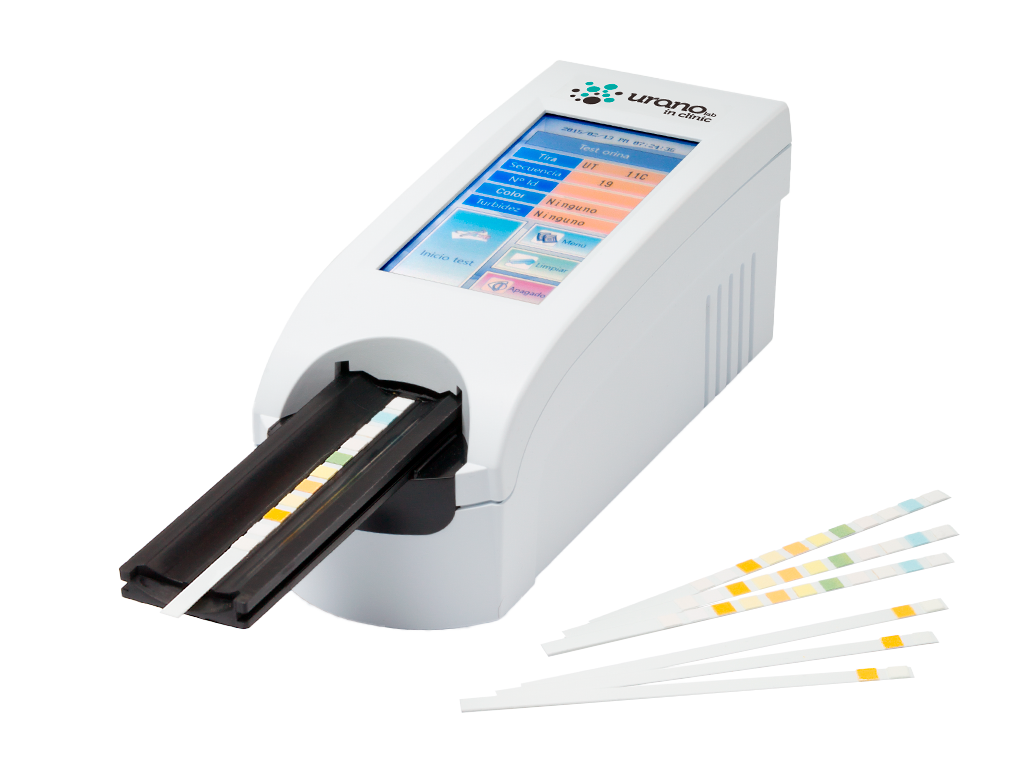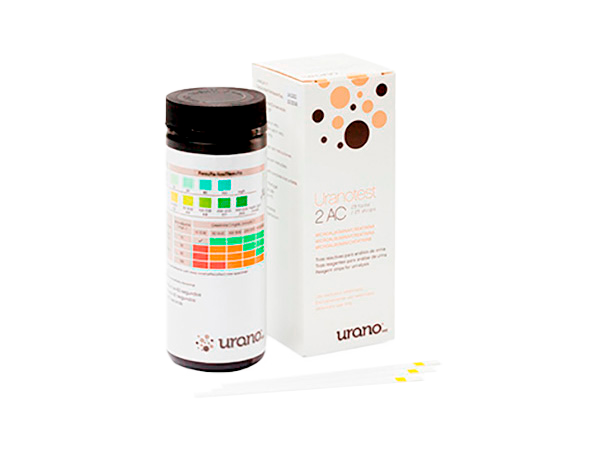
Diagnostic tests
Uranotest® Giardia
Detection of Giardia spp antigen in dog and cat faeces.
Test available for reading in the Uranotest® Smart Reader app.
Specs
- Purpose
Detecting Giardia spp antigen in faeces
- Sensitivity
100% versus microscopy
- Specificity
100% versus microscopy
- Execution time
1 minute
- Reading time
5-10 minutes
- Format
Boxes with 1, 5 or 10 tests
- Registration Nº
1648 RD
Characteristics
- Unlike microscopy, immunodiagnostic detection with Uranotest® Giardia avoids the need for repeated collection of faeces over 3-5 consecutive days.
- Superior sensitivity to microscopy as it avoids the problem of intermittent excretion of Giardia oocysts in the faeces. Storage at room emperature: time saved because no tempering is needed.
- Immunochromatographic technique involving just 2 steps: simplicity, time saving and less errors.
- This eliminates the diagnostic problem of intermittent Giardia cyst excretion in faeces. Much greater sensitivity than traditional microscopic techniques. No reactions crossed with other intestinal pathogens. More convenient for the pet owner: it is not necessary to collect samples for 3-5 days.
Information for the veterinarian
Uranotest® Giardia: good diagnosis, the key to effective control and prevention.
Good diagnosis of Giardia involves spotting a series of clinical and laboratory signs.
Clinical signs:
- Anorexia, apathy.
- Vomiting.
- Gelatinous, watery, bad-smelling diarrhoea, accompanied by abdominal distension and flatulence.
- Also, persistent diarrhoea with steatorrhoea.
Laboratory signs:
- Detection of trophozoites in fresh faeces samples (many false negatives in low load infections)
- Detection of oocysts in faeces by microscope (the excretion of oocysts is intermittent, leading to many falses negatives)
- PCR (rather expensive and hard to access to include in health procedures)
- Immunodiagnostic techniques (immunofluorescence, ELISA, immunochromatography) to detect antigens in faeces, making it possible to detect infestations even when the number of oocysts excreted is low.
G. intestinalis (duodenalis or lamblia) exists everywhere and its prevalence is rising. In developed countries it is considered the most common intestinal parasite in both pets and human beings.
In dogs and cats, prevalence is believed to be over 50%, and this is much higher among young animals than adults, especially those from pet importers and breeders with poor sanitary standards.
Giardia intestinalis infects a very wide range of vertebrates, classified in genotypes A to G according to host-specificity. Genotypes A and B are generally considered zoonotic.
Despite its pathogenicity for pets and zoonotic potential there is little awareness on the part of pet owners (and even sometimes among veterinarians) of the importance to the health of pets and those around them of controlling Giardia and other internal parasites.
Owners are concerned that their dog should be vaccinated because it will be in contact with their family and children, but the most frequent zoonoses are caused by parasites like Giardia and Toxocara rather than the micro-organisms against which vaccines are generally administered.
Veterinarians do not usually have procedures in place for diagnosing Giardia, despite its high clinical prevalence and the importance of diag nosing it in order to prescribe specific treatment, A single dose of a wide-spectrum antiparasitic is not enough to treat and prevent this illness.
Moreover, it has been established that one of the most frequent reasons for vaccination failure is an incorrect deworming.
It seems beyond doubt that the prevention, diagnosis and control of Giardia are an essential part of preventive health procedures for both young animals and adults.
Uranotest® Giardia, the tool the veterinarian needs for effective preventive treatment: recommended procedures.
Uranotest® Giardia is a kit for detecting Giardia antigen in faeces that makes it possible to confirm or rule out the presence of this parasite in dog and cat faeces simply, cheaply, quickly and reliably. Its ease of use means it can be used in prevention and control procedures, either alone or with the Uranotest® Copro coprological diagnosis kit.
When should a Giardia test be carried out?*
- Puppies and kittens to be brought into the home from breeders or importers of doubtful reliability, including those with signs of diarrhoea.
- Dogs or cats with signs of diarrhoea compatible with Giardia infestation, regardless of its source.
- Pregnant female dogs and cats to avoid contagion of litter.
- Pets from animal shelters and adoption centres to be brought into the home (due to the high prevalence of Giardia in group animal accommodation)
- A test should be carried out before bringing a pet into the home if there are other animals or children there, due to the risk of contagion and their zoonotic potential.
*An alternative to carrying out a Giardia test is a Uranotest® Copro coprological test. This system has the advantage that, as well as Giardia, it can detect other parasites such as coccidia, nematodes, trematodes and so on. The disadvantage is that it is a more subjective method that depends on the observer's experience. In the case of infestations with a low number of oocysts, it is hard to observe Giardia oocysts under the microscope if the observer lacks sufficient experience. The Uranotest® Giardia test provides objective information that does not depend on the observer's experience.
A good option is to carry out a coprological test with Uranotest® Copro. In the event that no Giardia oocysts are detected despite serious suspicion of infestation, the contents of the Uranotest® Copro vial can be used as a sample without needing to collect faeces again. The procedure is as follows:
- 1. Homogenise the contents of the Uranotest® Copro vial.
- 2. Take 8 drops of Greenfix® dilutant mixture + faeces and place them in the dilutant tube supplied with the Giardia kit.
- 3. Agitate gently to mix well and take 4 drops of the contents using the pipette supplied, and place them slowly, one by one, in the round test dish, following the instructions for the kit.
- 4. If the sample does not "migrate" this may be because you started with a Greenfix® + faeces sample containing too much faeces.
- The sample must be taken directly from the faecal mass or rectum walls. It is very important to avoid the part of the faeces with more content in blood and mucus, as this is just the part that contains the lowest antigen load.
- Take an adequate amount of faeces, not too much or too little.
Using an excessive volume of faeces may stop the sample “running" through the test membrane properly.
- Carrying out a Giardia test is not a good method to determine whether the treatment has been effective, as the test is highly sensitive and can detect Giardia antigen in faeces as a result of the original infestation several weeks after the symptoms have disappeared.
- When smears fresh faeces under microscope, take into account that Giardia trophozoites are very similar to those of Tritrichomonas foetus (cats) and the commensal Pentatritrichomonas hominis (dogs and cats). If trophozoites are detected in directly spread faeces with a negative Uranotest® Giardia result, the possibility must be considered that the trophozoite is one of the above mentioned protozoa.
- Treatments are often not effective and relapses are very common. The cause of relapse is not usually the inefficacy of the active principle used, but a reinfestation. Therefore, in addition to the diagnosis, it is important to investigate the pet's habits to prevent further exposure to Giardia. Suitable treatment together with effective sanitary hygiene measures (disinfecting premises, water treatment, baths in shampoo containing chlorhexidine, etc.) will help to control the process effectively.
Frequently Asked Questions
Detection of Giardia lamblia antigen in dog and cat faeces.
No. Veterinarians are used to diagnosing Giardia with a microscope, which is a reliable yet very unconvenient method for the pet owner and the veterinarian. This is because faeces need to be collected for 3-5 days to avoid the problem of intermittent Giardia excretion in faeces.
For puppies and kittens up to 5 months in age, especially those with intermittent diarrhoeas that do not respond to classic antiparasitics.
Also for adult dogs and cats with diarrhoea, it is recommended to include Giardia detection in the differential diagnostic.
Giardia is a public health problem, as it can be transmitted to humans. However, despite the fact the prevalence in puppies may reach up to 50%, there is no awareness as to the need for proper diagnosis and treatment. More attention is given to preventing other infectious or parasitic diseases in puppies that pose no risk to people and animals in the pet’s environment.
A positive result indicates the presence of Giardia in faeces. If there is no symptomatology, the pet should be considered as an invisible carrier that can act as a source of contagion.
The Giardia Uranotest® is highly sensitive and can detect very small antigen levels, and it is therefore enough to use a small amount of faeces. To the contrary, if we use an excessive sample volume or if it has particles that are too thick, this may interfere in the migration process of the sample on the test membrane. If you have used an excessive sample volume, mix well, wait a minute for the thickest particles to sediment and take the sample from the supernatant.
The appropriate sample volume is described in the insert of the kit.
Between 5 and 10 minutes, you can read with total reliability.
After that time, degradation and diffusion of the colours on the strip may occur. This does not happen with all tests, but the recommendation is that the test should always be repeated if the reading was not taken before the indicated time, since this may lead to an erroneous interpretation.

Uranotest® Giardia



